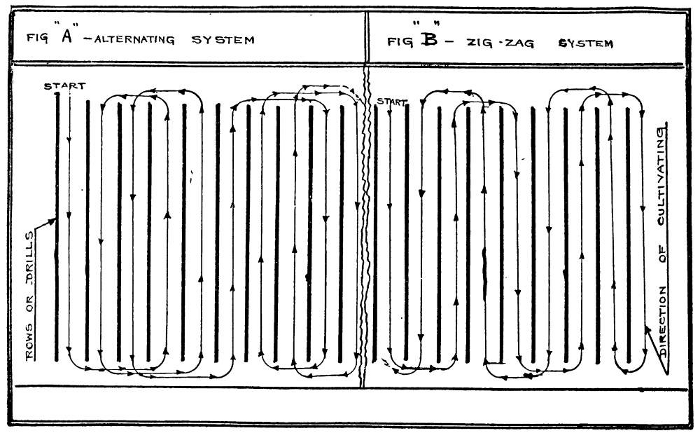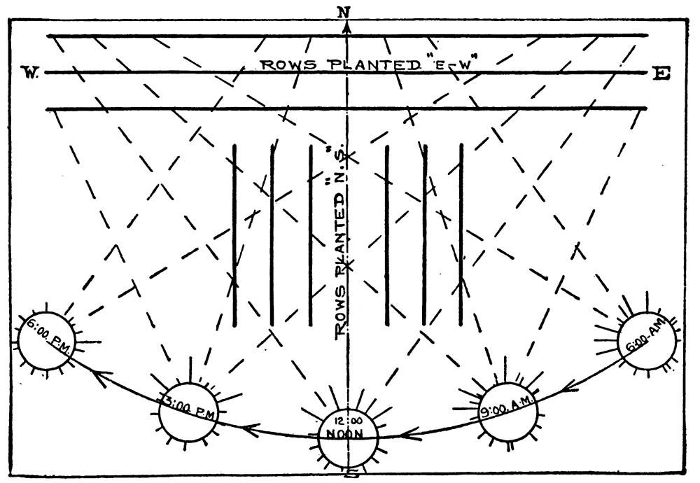The following information on lay-out of farm land comes from Five Acres and Independence by M. G. Kains. Five Acres and Independence is also available to purchase in print.
Apart from the character and the condition of the soil, the location of a farm and the crops to be grown two of the most important factors that influence profit and loss are the “lay” and the “lay-out” of the land. Lay always refers to natural features; lay-out to artificial ones. Items included in “lay” are elevation, aspect (or direction of slope), and level. Each of these has a bearing upon the character of farming that may be conducted.
For instance, other conditions being equal, a farm only say 10′ above sea level will be “earlier” and have a much longer season than another in the same latitude but 1,000′ above sea level. Similarly a farm 10′ above a large body of water such as a lake or a wider river, especially on the lee side, will be less likely to be affected by frosts in late spring and early fall than another on a level, perhaps only 1,000′ feet away. Also a field at the base of a slope or in a “pocket” between two or more slopes is surer to be frosty than the higher surrounding land because cold air flows like water from higher to lower levels.
Aspect generally refers to the tilt of the land. In commercial orcharding, though carefully considered when choosing the site of a large development, it is usually disregarded so far as small areas in the tract are concerned, the planting being continuous regardless of slope. In market gardening, poultry raising and various other branches of farming, however, aspect is highly important. It may even mean the difference between large and small profits or even losses.
A slope toward the south is almost always the warmest so is best suited to greenhouses, hotbeds and coldframes, outdoor early crops and poultry raising. Next come in usual order southeasterly, southwesterly, east, west, northeast, northwest and finally north. The effect of a northerly slope is to retard growth. Hence the flower buds of apricot and peach trees on a northern slope are less likely to be destroyed by frosts which follow warm spells in winter and early spring, than in the same orchard where during the same cold snaps the buds on trees on a south or southerly slope are killed.
The lay of the land modifies production; lay-out varies the cost of operation; both affect profits. When forest lands were first cleared it was necessary to get rid of the wood, so great piles were burned. Other quantities were split into rails to make “snake” or “zigzag” fences. Many fences were also made out of pine and other resinous tree stumps. Rocks and stones had also to be removed before farming could be done well, so these were made into walls from 2′ to sometimes more than 10′ thick.
As the fields were mostly small and as fences and walls of these kinds require strips of ground 10′ to 15′ wide they are wasteful of land and highly objectionable. They propagate weeds, shelter insects and animals that attack crops and annually require time, labor and expense to cut the growths of bushes and trees that start in them. The remedy is to get rid of them and thus combine several small fields into larger ones. Often this is easier said than done; for though rail fences may be used for fuel, stump fences and stone walls require considerable work to remove.
Not everybody whose farm is minced into little fields by stone walls is so fortunate as I was when new roads were being built past my property. The stones of the interior and inferior walls were given to the contractor. Thus at no cost to me several small fields were thrown into a few large ones.
Another advantage of getting rid of walls and fences is that the new fields are of far more regular form than the small ones. Irregular fields demand far more time to manage than rectangular ones of similar size. Especially is this the case when the length can be greater than the breadth; for plowing, harrowing and other work may be done from end to end thus reducing the number of turns. Even with the wheelhoe there is an appreciable saving of time in making few rather than many turns. (Fig. 4)

When full rows of any crop would produce too large a quantity of any one vegetable parts of the row may be shared by other crops that require the same treatment. When it is necessary to have cross paths, breaks of sufficient width may be made in the rows across the area for this purpose. These will therefore not interfere with plowing, harrowing or tillage as would permanent roads, fences or walls: the whole area may be handled from end to end. None but necessary fences, roads or walks should be permanent.
Advantages may be gained by having the rows run north and south when the fields extend that way, because this arrangement favors even distribution of the sunlight. (Fig. 5)

Other features of lay-out that should be noted when appraising a farm and when laying out the place after buying it are location of the well and the watering equipment in the buildings and elsewhere, the presence and condition (or the absence) of windbreaks, drains, lanes, lawns, shrubbery, orchards, berry patches, vineyards, etc.
